Mwalimu-G
Elder Lister
22 Pieces of Medieval Pet Advice

By Kerry Wolfe
Apr 4, 2022

No matter what era you're in, your cat should be king. / Wikimedia Commons // Public Domain (U.S.)



Pet advice from the Middle Ages isn't exactly like pet advice from today. Sure, you have your diet tips and expectations for obedience, but there's also a smattering of Latin incantations, unusual remedies, and enough superstition to fill a Great Dane. And, of course, most of these "tips" come with a big “do not try this at home” attached to them. It's important to remember that, in the Middle Ages, most animals had a purpose. Even creatures we’d typically think of as pets today, like cats and dogs, had jobs to do. Cats were meant to catch mice and keep homes rodent-free, while dogs could be trained for a range of jobs, from tracking and hunting prey to guarding flocks of sheep. During this time, having a pet for pure pleasure was a luxury only the elite could afford to enjoy.
With that in mind, here are a few fascinating pieces of medieval pet advice, adapted from an episode of The List Show on YouTube
1. Feed your dog bread soaked in dirty water to keep it small.
Long before the days of designer dogs, people had some unusual methods of creating a pocket-sized pet. One 15th-century manuscript suggests a breeder soak some bread in water they’d previously washed their hands with. Feeding that soggy bread to the puppies they had bred supposedly ensured a dog would not grow any bigger than a person’s hand.
2. Don't get a house pet—unless you're a woman or a cleric.
If a medieval person was going to have a pampered house pet, they had better be a woman or a member of the clergy. Pets were particularly common among aristocratic ladies: Wealthy women kept everything from little white lap dogs to exotic birds to monkeys and even squirrels. Unlike beasts of burden, the main purpose of these animals was to entertain and provide companionship. They were also kept inside (the outdoors was the domain of men). Because clerics spent much of their time indoors, they, too, could own pets.
3. In a pinch, use your pup as a heating pad.
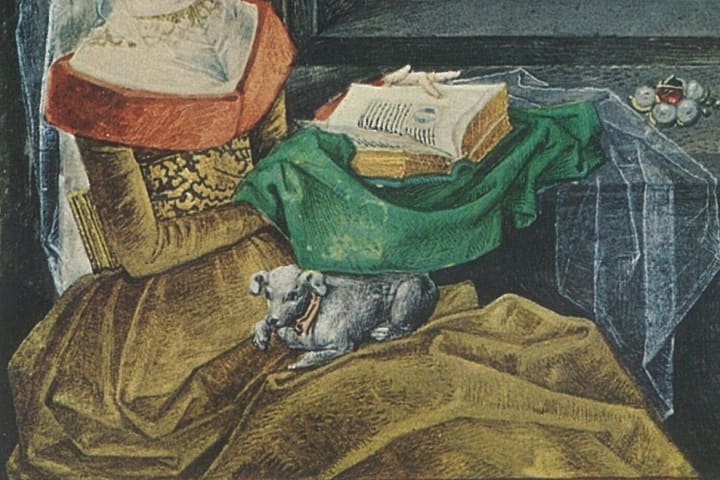
A lap dog. / Wikimedia Commons // Public Domain
A woman’s lap dog may not be good for hunting or any sort of actual labor. But they could serve one interesting purpose: One bit of medieval medical advice basically suggested using a small dog as a heating pad by pressing it against the body to deal with pain and sickness.
4. Get your pet a jewel-encrusted collar.
If someone really wanted to show off their wealth, they’d get their pet some fancy accessories. In the Middle Ages, wealthy women adorned their pet dogs and squirrels with delicate collars made from gold, silver, or fine leather, adorned with jewels.
5. Know how to determine your pet’s worth.
Figuring out the value of a pet itself wasn’t as straightforward as purchasing an accessory. According to the Catṡlechta, a medieval Irish legal document about felines, a cat that could both purr and hunt mice was worth three cows. If a cat was on the lazier side and preferred purring instead of hunting mice, it was only worth 1.5 cows. A kitten, meanwhile, was only worth one-ninth of its mother’s value until it was weaned.
Tenth-century Welsh King Hywel Dda had a different set of rules for assessing a pet’s value: Kittens were worth one penny until they opened their eyes, two pence once their eyes opened, and four pence once they started hunting.
According to a medieval German law, if someone killed an adult cat, they had to pay its owner 60 bushels of grain. Dogs, on the other hand, were priced based on their owner’s status: A king’s pet dog could fetch a pound, whereas a serf’s pup was worth a mere four pence.
6. Men, keep your animals out of the house.
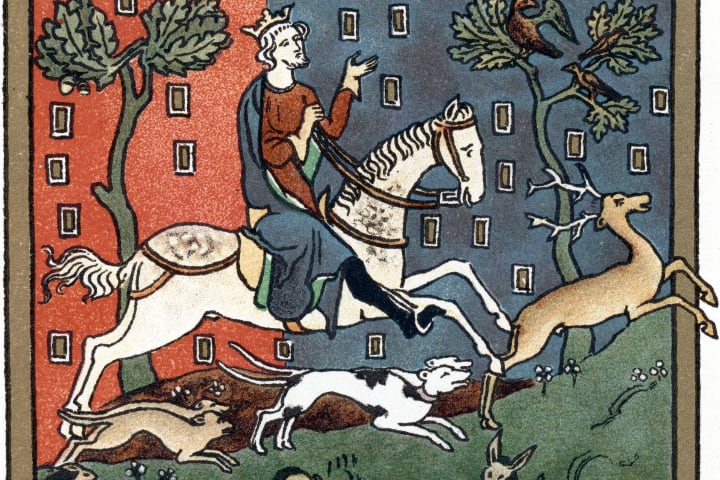
A Plantagenet king of England out hunting. / Print Collector/GettyImages
Medieval men could keep animals, but they were used for hunting or sport—think falconry birds, hunting dogs, and fancy horses. Though these animals were valuable, they weren’t spoiled the way house pets were. Men liked to have animals that reflected certain desirable personality traits: They wanted creatures that were strong, fierce, and loyal—not something frivolous like a fluffy dog or a squawking parrot. Their animals were kept outdoors and were taken care of by hired help. Rather than sleep on a luxurious pillow like an indoor pet, hunting dogs were to sleep in wooden kennels filled with fresh straw and clean water.
7. Everybody (Fido included) likes bread.
Medieval pet dogs were basically fed like a picky toddler: They dined on meat, milk, bread, and sometimes, a bit of porridge. Bread, usually made from wheat, was a big part of a dog’s diet back then (it may seem like an odd choice, but a lot of modern dog food contains grains like wheat, too). There was some controversy around these dog diets, though: Some people felt that the dog’s daily feasts of bread, milk, and meat should have gone to less fortunate people, who weren’t able to afford such fare.
8. Cheese + Latin incantations = one quiet dog.
The Distaff Gospels, a collection of old wives’ tales from the Middle Ages, says that to keep a dog from barking, a person should feed it a nice hunk of roasted cheese while uttering the phrase “In camo et freno, et cetera,” a shortened version of a Biblical Psalm that, in translation, reads something like “with bit and bridle bind fast their jaws who come not near to thee.”
9. No dogs in the dining hall.
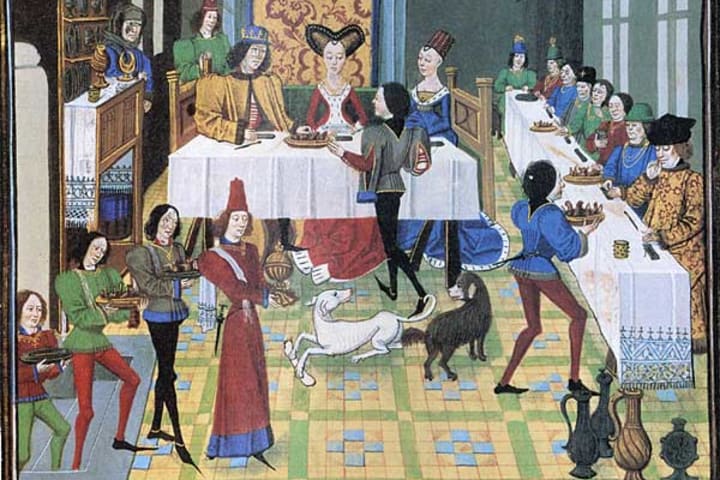
Dogs in the dining hall? What a scandal! / Wikimedia Commons // Public Domain
According to 15th-century etiquette rules, a person should not make a dog “thi felow at the tabull round” [sic]. Translation: No dogs in the dining hall. And no feeding a pet from a person’s own dinner plate, either.
10. Doggie mealtimes are determined by the season.
In the winter, dogs should only be fed at sunset to keep them fit for the next morning’s hunt. But in the warmer months, they should get multiple small meals per day.
11. Don’t overfeed your pet, lest you seem immoral.
It was unwise to feed animals too much, then as now, though maybe for different reasons. People often viewed a fat pet as a bad reflection of its owner’s values, as it showed that they cared more for their pets than for the poor. Albertus Magnus, writing in the 13th century, warned of the dangers of over-feeding a pet, saying that it was often ladies who spoiled their beloved little dogs. According to Magnus, these porky pups were prone to constipation because of their rich diets. He advised feeding them a porridge of oatmeal and warm water or leavened soft bread and milk whey to get things moving. A dog that was too thin, on the other hand, should be fed a lot of butter to fatten it up.
12. Dole out your pettings judiciously.
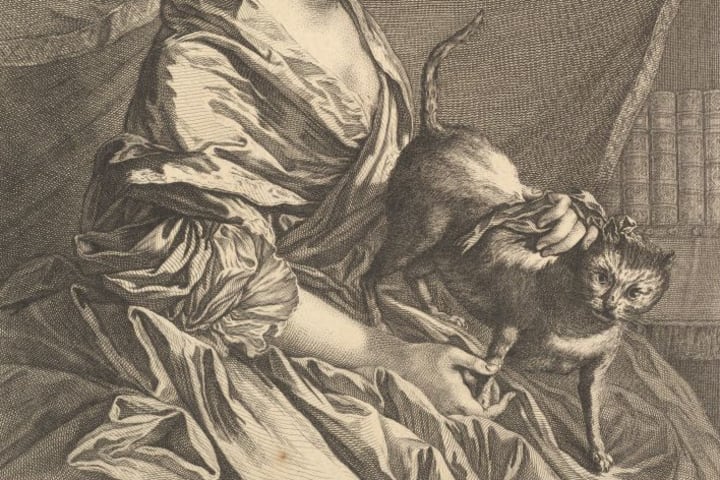
Cats like pets, too (even if this one doesn't seem excited). / Heritage Images/GettyImages
The amount of time a medieval person would spend petting their animal depended on the species. Like modern cats, medieval cats demanded attention. Albertus Magnus wrote, “This animal loves to be lightly stroked by human hands,” and also noted that they can be quite playful. Etiquette books in the 15th-century claimed it was poor manners to pet a cat or dog during meals. People were also advised not to pet their dogs due to a fear that they would lose their tracking ability if they were motivated to seek out the people they liked.
In medieval Europe, it was also a bad look for men to be overly affectionate with their animals. In Islamic countries, however, owners were encouraged to regularly pet their hunting dogs. They were advised to comb their fur with a soothing material like silk, and to stroke, scratch, and touch the dogs daily.
13. Call your dog “brother” or “friend.”
But just because European dog owners couldn’t be overly affectionate with their animals doesn’t mean they couldn’t be kind. In the 14th century, Gaston Phébus, the Count of Foix, basically wrote the book on medieval hunting. When it came to training hunting dogs, he believed in the power of positive reinforcement. According to Phébus, a hunter should address his canine companion as brother or friend. And if a dog failed to follow its master’s command, the handler—not the pup—was to blame for the miscommunication.
14. Even men should appreciate cats.
Though it wasn’t considered particularly manly to have a cat, men were still advised to appreciate felines. According to The Distaff Gospels, “Young men should not hate cats because they are the cause of great happiness and can assist in achieving success in matters of love with young and charming ladies.”
15. Pet remedies include tansy juice and ground marshmallow.
Veterinary advice for medieval pet owners was pretty dubious by today’s standards. Albertus Magnus wrote that if your dog has worms in its wound, you should treat it with wild tansy juice. To mend a swollen limb, apply a compress of ground marshmallow and water. The Distaff Gospels suggest letting a dog that has been exposed to rabies drink from a trivet, which would somehow magically protect them from the disease.
16. Try a salt/onion/honey poultice on a monkey bite.
The medical advice for owners injured by their pets was a bit iffy as well. If someone was bitten by their pet monkey, for example, they were told to put a blend of crushed salt, onions, and honey on the wound.
17. Be careful around cats in pursuit of a mouse.
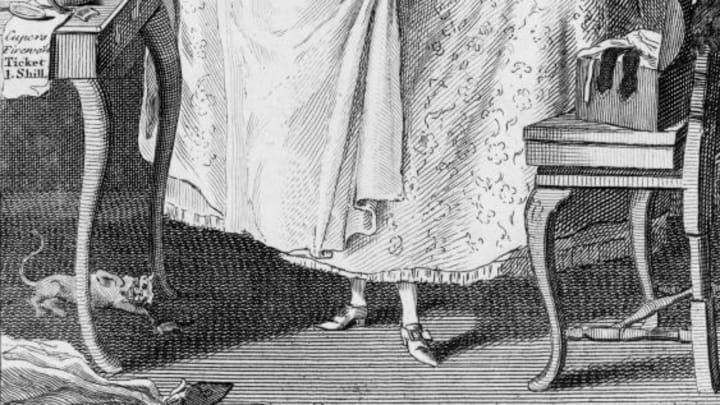
The Harlots Nurse Or Modern Procuress / Heritage Images/GettyImages
Speaking of being injured by an animal: A medieval person had to be careful if they were near a hunting cat. If they got scratched, bitten, or otherwise injured by a cat that was in pursuit of a mouse and wanted retribution, then they were out of luck. According to the Catṡlechta, a cat is not liable if it happens to hurt someone who “had no business being there” while it was hunting a rodent.
18. Follow these complicated steps to keep your cat from straying.
Cats, being cats, often like to wander. The Distaff Gospels offered medieval cat owners some pretty odd advice on how to keep their felines from straying too far: A person must turn the cat three times around the pot hook, then rub its legs against their chimney wall. If they do that, the cat will never leave. If that solution didn’t appeal to the owner, they could slather the cat’s legs with butter for three nights to make them stay put.
19. Use your cat to determine the weather.
The Distaff Gospels also advised people to use their cats as a meow-teorologists. According to an account documented in the manuscript, if a cat is sitting in the window licking its behind and rubbing its ear, that means a person should hold off on doing laundry because rain is coming.
20. Know how to quell your male cat's murderous fantasies.
To keep a male cat from strangling you—which was apparently something cat parents worried about “night and day” once a kitty turned 4 years old—The Distaff Gospels advised owners to cut off a chunk of tail the size of their palm. (Not OK!)
21. Rub your cat’s nose in what it damages to prevent future cat burglary.
And if a person’s cat was more of a thief than a murderer, the owner should rub its nose “three times in what it has damaged” to prevent it from stealing again.
22. Slip your husband some dog urine to ensure happy relations.
If a woman wanted her husband to learn to like her family and friends, according to The Distaff Gospels, she'd need enlist the help of some of dog urine. When said friends and family members visit with their dog, a woman should collect Fido’s pee, then secretly put it in her husband’s beer or soup. Once the man has drunk the urine-spiked beverage, he’ll become friendly with both the dog and the people who own it.

By Kerry Wolfe
Apr 4, 2022

No matter what era you're in, your cat should be king. / Wikimedia Commons // Public Domain (U.S.)
Pet advice from the Middle Ages isn't exactly like pet advice from today. Sure, you have your diet tips and expectations for obedience, but there's also a smattering of Latin incantations, unusual remedies, and enough superstition to fill a Great Dane. And, of course, most of these "tips" come with a big “do not try this at home” attached to them. It's important to remember that, in the Middle Ages, most animals had a purpose. Even creatures we’d typically think of as pets today, like cats and dogs, had jobs to do. Cats were meant to catch mice and keep homes rodent-free, while dogs could be trained for a range of jobs, from tracking and hunting prey to guarding flocks of sheep. During this time, having a pet for pure pleasure was a luxury only the elite could afford to enjoy.
With that in mind, here are a few fascinating pieces of medieval pet advice, adapted from an episode of The List Show on YouTube
1. Feed your dog bread soaked in dirty water to keep it small.
Long before the days of designer dogs, people had some unusual methods of creating a pocket-sized pet. One 15th-century manuscript suggests a breeder soak some bread in water they’d previously washed their hands with. Feeding that soggy bread to the puppies they had bred supposedly ensured a dog would not grow any bigger than a person’s hand.
2. Don't get a house pet—unless you're a woman or a cleric.
If a medieval person was going to have a pampered house pet, they had better be a woman or a member of the clergy. Pets were particularly common among aristocratic ladies: Wealthy women kept everything from little white lap dogs to exotic birds to monkeys and even squirrels. Unlike beasts of burden, the main purpose of these animals was to entertain and provide companionship. They were also kept inside (the outdoors was the domain of men). Because clerics spent much of their time indoors, they, too, could own pets.
3. In a pinch, use your pup as a heating pad.

A lap dog. / Wikimedia Commons // Public Domain
A woman’s lap dog may not be good for hunting or any sort of actual labor. But they could serve one interesting purpose: One bit of medieval medical advice basically suggested using a small dog as a heating pad by pressing it against the body to deal with pain and sickness.
4. Get your pet a jewel-encrusted collar.
If someone really wanted to show off their wealth, they’d get their pet some fancy accessories. In the Middle Ages, wealthy women adorned their pet dogs and squirrels with delicate collars made from gold, silver, or fine leather, adorned with jewels.
5. Know how to determine your pet’s worth.
Figuring out the value of a pet itself wasn’t as straightforward as purchasing an accessory. According to the Catṡlechta, a medieval Irish legal document about felines, a cat that could both purr and hunt mice was worth three cows. If a cat was on the lazier side and preferred purring instead of hunting mice, it was only worth 1.5 cows. A kitten, meanwhile, was only worth one-ninth of its mother’s value until it was weaned.
Tenth-century Welsh King Hywel Dda had a different set of rules for assessing a pet’s value: Kittens were worth one penny until they opened their eyes, two pence once their eyes opened, and four pence once they started hunting.
According to a medieval German law, if someone killed an adult cat, they had to pay its owner 60 bushels of grain. Dogs, on the other hand, were priced based on their owner’s status: A king’s pet dog could fetch a pound, whereas a serf’s pup was worth a mere four pence.
6. Men, keep your animals out of the house.

A Plantagenet king of England out hunting. / Print Collector/GettyImages
Medieval men could keep animals, but they were used for hunting or sport—think falconry birds, hunting dogs, and fancy horses. Though these animals were valuable, they weren’t spoiled the way house pets were. Men liked to have animals that reflected certain desirable personality traits: They wanted creatures that were strong, fierce, and loyal—not something frivolous like a fluffy dog or a squawking parrot. Their animals were kept outdoors and were taken care of by hired help. Rather than sleep on a luxurious pillow like an indoor pet, hunting dogs were to sleep in wooden kennels filled with fresh straw and clean water.
7. Everybody (Fido included) likes bread.
Medieval pet dogs were basically fed like a picky toddler: They dined on meat, milk, bread, and sometimes, a bit of porridge. Bread, usually made from wheat, was a big part of a dog’s diet back then (it may seem like an odd choice, but a lot of modern dog food contains grains like wheat, too). There was some controversy around these dog diets, though: Some people felt that the dog’s daily feasts of bread, milk, and meat should have gone to less fortunate people, who weren’t able to afford such fare.
8. Cheese + Latin incantations = one quiet dog.
The Distaff Gospels, a collection of old wives’ tales from the Middle Ages, says that to keep a dog from barking, a person should feed it a nice hunk of roasted cheese while uttering the phrase “In camo et freno, et cetera,” a shortened version of a Biblical Psalm that, in translation, reads something like “with bit and bridle bind fast their jaws who come not near to thee.”
9. No dogs in the dining hall.

Dogs in the dining hall? What a scandal! / Wikimedia Commons // Public Domain
According to 15th-century etiquette rules, a person should not make a dog “thi felow at the tabull round” [sic]. Translation: No dogs in the dining hall. And no feeding a pet from a person’s own dinner plate, either.
10. Doggie mealtimes are determined by the season.
In the winter, dogs should only be fed at sunset to keep them fit for the next morning’s hunt. But in the warmer months, they should get multiple small meals per day.
11. Don’t overfeed your pet, lest you seem immoral.
It was unwise to feed animals too much, then as now, though maybe for different reasons. People often viewed a fat pet as a bad reflection of its owner’s values, as it showed that they cared more for their pets than for the poor. Albertus Magnus, writing in the 13th century, warned of the dangers of over-feeding a pet, saying that it was often ladies who spoiled their beloved little dogs. According to Magnus, these porky pups were prone to constipation because of their rich diets. He advised feeding them a porridge of oatmeal and warm water or leavened soft bread and milk whey to get things moving. A dog that was too thin, on the other hand, should be fed a lot of butter to fatten it up.
12. Dole out your pettings judiciously.

Cats like pets, too (even if this one doesn't seem excited). / Heritage Images/GettyImages
The amount of time a medieval person would spend petting their animal depended on the species. Like modern cats, medieval cats demanded attention. Albertus Magnus wrote, “This animal loves to be lightly stroked by human hands,” and also noted that they can be quite playful. Etiquette books in the 15th-century claimed it was poor manners to pet a cat or dog during meals. People were also advised not to pet their dogs due to a fear that they would lose their tracking ability if they were motivated to seek out the people they liked.
In medieval Europe, it was also a bad look for men to be overly affectionate with their animals. In Islamic countries, however, owners were encouraged to regularly pet their hunting dogs. They were advised to comb their fur with a soothing material like silk, and to stroke, scratch, and touch the dogs daily.
13. Call your dog “brother” or “friend.”
But just because European dog owners couldn’t be overly affectionate with their animals doesn’t mean they couldn’t be kind. In the 14th century, Gaston Phébus, the Count of Foix, basically wrote the book on medieval hunting. When it came to training hunting dogs, he believed in the power of positive reinforcement. According to Phébus, a hunter should address his canine companion as brother or friend. And if a dog failed to follow its master’s command, the handler—not the pup—was to blame for the miscommunication.
14. Even men should appreciate cats.
Though it wasn’t considered particularly manly to have a cat, men were still advised to appreciate felines. According to The Distaff Gospels, “Young men should not hate cats because they are the cause of great happiness and can assist in achieving success in matters of love with young and charming ladies.”
15. Pet remedies include tansy juice and ground marshmallow.
Veterinary advice for medieval pet owners was pretty dubious by today’s standards. Albertus Magnus wrote that if your dog has worms in its wound, you should treat it with wild tansy juice. To mend a swollen limb, apply a compress of ground marshmallow and water. The Distaff Gospels suggest letting a dog that has been exposed to rabies drink from a trivet, which would somehow magically protect them from the disease.
16. Try a salt/onion/honey poultice on a monkey bite.
The medical advice for owners injured by their pets was a bit iffy as well. If someone was bitten by their pet monkey, for example, they were told to put a blend of crushed salt, onions, and honey on the wound.
17. Be careful around cats in pursuit of a mouse.

The Harlots Nurse Or Modern Procuress / Heritage Images/GettyImages
Speaking of being injured by an animal: A medieval person had to be careful if they were near a hunting cat. If they got scratched, bitten, or otherwise injured by a cat that was in pursuit of a mouse and wanted retribution, then they were out of luck. According to the Catṡlechta, a cat is not liable if it happens to hurt someone who “had no business being there” while it was hunting a rodent.
18. Follow these complicated steps to keep your cat from straying.
Cats, being cats, often like to wander. The Distaff Gospels offered medieval cat owners some pretty odd advice on how to keep their felines from straying too far: A person must turn the cat three times around the pot hook, then rub its legs against their chimney wall. If they do that, the cat will never leave. If that solution didn’t appeal to the owner, they could slather the cat’s legs with butter for three nights to make them stay put.
19. Use your cat to determine the weather.
The Distaff Gospels also advised people to use their cats as a meow-teorologists. According to an account documented in the manuscript, if a cat is sitting in the window licking its behind and rubbing its ear, that means a person should hold off on doing laundry because rain is coming.
20. Know how to quell your male cat's murderous fantasies.
To keep a male cat from strangling you—which was apparently something cat parents worried about “night and day” once a kitty turned 4 years old—The Distaff Gospels advised owners to cut off a chunk of tail the size of their palm. (Not OK!)
21. Rub your cat’s nose in what it damages to prevent future cat burglary.
And if a person’s cat was more of a thief than a murderer, the owner should rub its nose “three times in what it has damaged” to prevent it from stealing again.
22. Slip your husband some dog urine to ensure happy relations.
If a woman wanted her husband to learn to like her family and friends, according to The Distaff Gospels, she'd need enlist the help of some of dog urine. When said friends and family members visit with their dog, a woman should collect Fido’s pee, then secretly put it in her husband’s beer or soup. Once the man has drunk the urine-spiked beverage, he’ll become friendly with both the dog and the people who own it.
